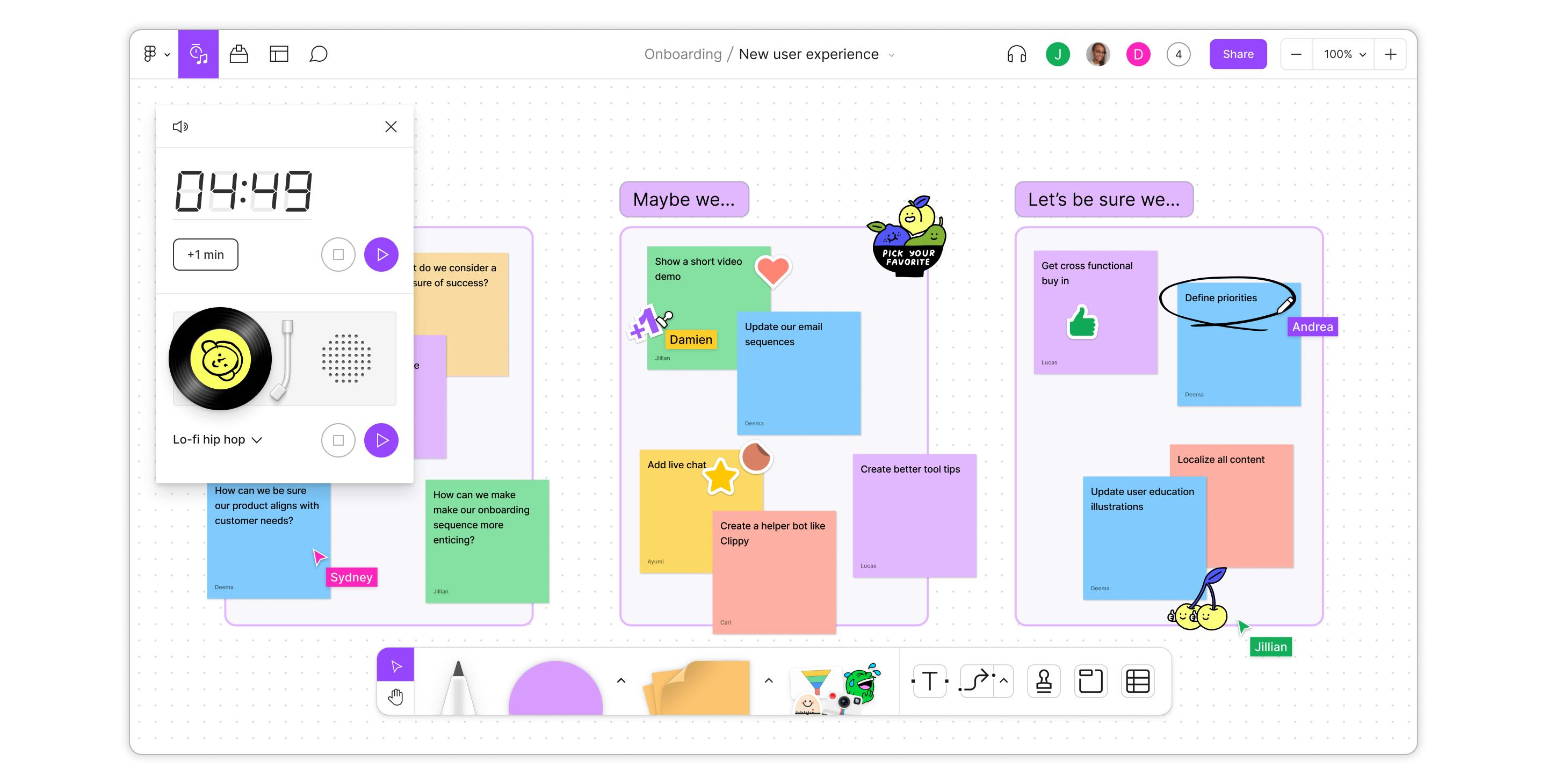
FigJam: Complete Buyer's Guide
Collaborative whiteboard extension of the Figma design ecosystem
FigJam positions itself as the collaborative whiteboard extension of the Figma design ecosystem, delivering AI-enhanced ideation and workshop facilitation capabilities specifically optimized for design-centric teams. The platform differentiates through seamless integration with Figma's design environment, enabling direct translation of whiteboard concepts into high-fidelity prototypes without manual recreation[212][217].
Market Position & Maturity
Market Standing
FigJam operates as a specialized extension of the established Figma platform rather than an independent whiteboard solution, leveraging Figma's market-leading position in design tools to establish credibility in collaborative whiteboarding. The platform benefits from Figma's enterprise adoption and brand recognition while maintaining focused functionality rather than pursuing comprehensive whiteboard market leadership[212][217].
Company Maturity
Business maturity indicators demonstrate operational stability through SOC 2 compliance for enterprise requirements and 24/7 support infrastructure with dedicated customer success management for enterprise customers over 100 users[222][229][230].
Growth Trajectory
Growth trajectory evidence shows concentration in technology (62%), education (23%), and consulting (15%) sectors, indicating successful penetration within innovation-focused organizations[212][230]. However, growth appears constrained by Figma ecosystem dependency, creating both advantages for existing Figma users and limitations for broader market expansion.
Strategic Partnerships
Strategic partnership position centers entirely on Figma ecosystem integration rather than diverse partnership development. This focused approach creates strong value for Figma-native teams but limits appeal for organizations seeking best-in-class whiteboard capabilities independent of design tool integration[212][217].
Longevity Assessment
Long-term viability assessment benefits from Figma's market position and continued investment in collaborative design capabilities. The platform's specialized positioning reduces direct competitive pressure while creating dependency on Figma's strategic direction and market success.
Proof of Capabilities
Customer Evidence
Customer evidence demonstrates measurable outcomes across technology, education, and consulting sectors. UX researchers report significant reduction in research synthesis time through AI-assisted sticky note clustering, enabling faster thematic analysis of qualitative data[211][215][230].
Quantified Outcomes
Quantified implementation outcomes show basic functionality operational within one hour of activation, with advanced AI template customization requiring 3-5 days of training investment[216][218].
Market Validation
Market validation evidence includes customer preference patterns showing Figma users consistently choose FigJam for seamless design handoffs, achieving efficiency gains that justify the investment[227][228][212][217].
Competitive Wins
Competitive win scenarios emerge primarily within Figma-integrated environments where ecosystem cohesion creates measurable workflow value. Customer evidence indicates teams prioritizing design handoff capabilities consistently select FigJam over alternatives with broader standalone functionality[227][228].
Reference Customers
Reference customer validation spans multiple sectors with verified testimonials highlighting practical benefits in research synthesis and workshop facilitation. One UX professional reported: "FigJam AI cut our research synthesis significantly. The sticky sorting feature provides substantial value"[230].
AI Technology
FigJam's AI implementation centers on practical workflow automation rather than experimental features, distinguishing it from competitors pursuing broader but less mature AI capabilities. The platform's sticky note sorting capability reduces manual organization time for UX teams, enabling faster thematic clustering of ideas following workshop sessions through intelligent content analysis[215][218].
Architecture
Deployment architecture utilizes cloud-native infrastructure eliminating data migration fees, with basic functionality operational within hours of activation[216][218][220][222]. However, organizations maximizing AI features benefit from prompt engineering skill development, suggesting 3-5 days training investment for optimal utilization[215][218]. The platform lacks native offline capabilities, creating accessibility concerns in bandwidth-limited environments[216][226].
Primary Competitors
Primary competitive landscape positions FigJam against Miro's comprehensive whiteboard functionality with advanced automation and 100+ application integrations, Lucidspark for process-centric diagramming requirements, and Microsoft Whiteboard for Office 365-integrated environments[213][217][227][228].
Competitive Advantages
Core competitive advantages center on Figma ecosystem integration enabling direct translation of whiteboard concepts into high-fidelity prototypes without manual recreation required by competitors[212][217]. Real-time cursor chat and voting stamps generate higher engagement metrics compared to static alternatives, supporting more dynamic collaborative sessions[212][228].
Market Positioning
Market positioning strategy focuses on specialized positioning as the collaborative extension of Figma rather than comprehensive whiteboard platform competition. This approach creates advantages for Figma users while limiting appeal for organizations seeking best-in-class standalone whiteboard capabilities[212][217].
Win/Loss Scenarios
Win/loss scenario analysis shows FigJam consistently wins when Figma ecosystem integration creates measurable workflow value and collaborative design represents the primary use case. The platform loses consideration when organizations require standalone whiteboard functionality, advanced automation, or extensive third-party integrations[213][217][227][228].
Key Features

Pros & Cons
Use Cases
Pricing
Featured In Articles
Comprehensive analysis of AI Whiteboard Illustration for AI Design for AI Design professionals. Expert evaluation of features, pricing, and implementation.
How We Researched This Guide
About This Guide: This comprehensive analysis is based on extensive competitive intelligence and real-world implementation data from leading AI vendors. StayModern updates this guide quarterly to reflect market developments and vendor performance changes.
230+ verified sources per analysis including official documentation, customer reviews, analyst reports, and industry publications.
- • Vendor documentation & whitepapers
- • Customer testimonials & case studies
- • Third-party analyst assessments
- • Industry benchmarking reports
Standardized assessment framework across 8 key dimensions for objective comparison.
- • Technology capabilities & architecture
- • Market position & customer evidence
- • Implementation experience & support
- • Pricing value & competitive position
Research is refreshed every 90 days to capture market changes and new vendor capabilities.
- • New product releases & features
- • Market positioning changes
- • Customer feedback integration
- • Competitive landscape shifts
Every claim is source-linked with direct citations to original materials for verification.
- • Clickable citation links
- • Original source attribution
- • Date stamps for currency
- • Quality score validation
Analysis follows systematic research protocols with consistent evaluation frameworks.
- • Standardized assessment criteria
- • Multi-source verification process
- • Consistent evaluation methodology
- • Quality assurance protocols
Buyer-focused analysis with transparent methodology and factual accuracy commitment.
- • Objective comparative analysis
- • Transparent research methodology
- • Factual accuracy commitment
- • Continuous quality improvement
Quality Commitment: If you find any inaccuracies in our analysis on this page, please contact us at research@staymodern.ai. We're committed to maintaining the highest standards of research integrity and will investigate and correct any issues promptly.